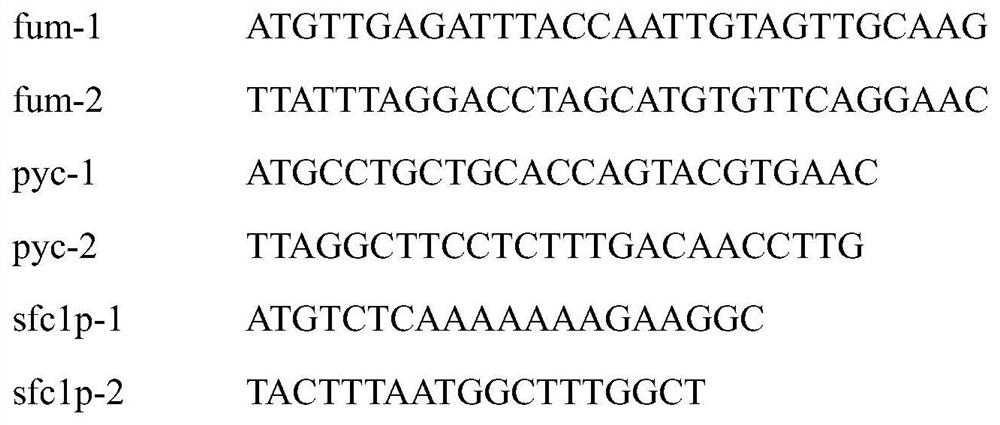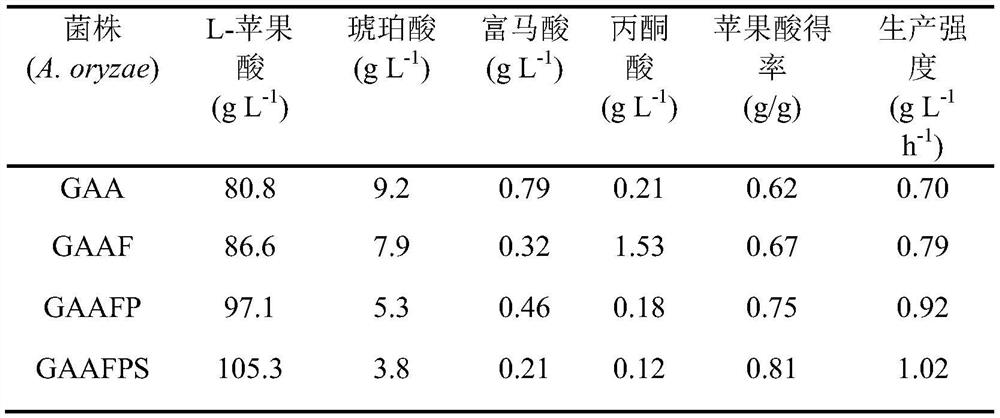A kind of Aspergillus oryzae that reduces the accumulation of by-products in the process of malic acid synthesis and its application
A technology of Aspergillus oryzae and malic acid, which is applied in the field of genetic engineering, can solve the problems such as no by-product regulation of malic acid, and achieve the effect of simple and efficient metabolic engineering methods and strategies.
- Summary
- Abstract
- Description
- Claims
- Application Information
AI Technical Summary
Problems solved by technology
Method used
Image
Examples
Embodiment 1
[0025] Construction of embodiment 1 overexpression vector
[0026] Primers were designed according to the gene sequences of FUM I, Ropyc and sfc1p published on NCBI:
[0027]
[0028] Target genes were amplified by PCR using the genomes of Saccharomyces cerevisiae and Rhizopus oryzae as templates. Among them, the extraction method of Saccharomyces cerevisiae genome is the method of Genome Extraction Kit for Rhizopus cerevisiae, and the method for extracting the genome of Rhizopus oryzae is the method of Genome Extraction Kit for Rhizopus oryzae Genome. The fusion product of the starting plasmid pMD-ETPBG and the target gene with the promoter and terminator derived from Aspergillus oryzae was cut with Not I and Asc I enzymes, and the target DNA was recovered and purified by 1% agarose gel electrophoresis. The purified digested products were ligated overnight with T4 DNA ligase, and transformed into competent Escherichia coli GM 109. The transformed bacterial suspension was...
Embodiment 2
[0029] Embodiment 2 Aspergillus oryzae protoplast transforms and the screening of transformant
[0030] The Aspergillus oryzae recombination method is the protoplast transformation method, and the protoplast preparation method refers to the literature Brown, S.H., Bashkirova, L., Berka, R., Chandler, T., Doty, T., McCall, K., McCulloch, M., McFarland, S., Thompson, S., Yaver, D., Berry, A., 2013. Metabolic engineering of Aspergillusoryzae NRRL3488 for increased production of L-malic acid. Appl Microb Biotech. 97, 8903-8912. For the protoplast transformation method, refer to the literature Blumhoff, M., Steiger, M.G., Marx, H., Mattanovich, D., Sauer, M., 2013. Six novel constitutive promoters formetabolic engineering of Aspergillusniger. Appl Microb Biotech.97, 259-267.
[0031] The host bacterium used for transformation is A.oryzaeGAA, and the transformation product is coated with a bleomycin-resistant plate. The genome of the regenerated protoplast strain was extracted for ...
Embodiment 3
[0032] Embodiment 3 Aspergillus oryzae fermentation produces L-malic acid
[0033] The spores of Aspergillus oryzae cultured at 34°C for 3-5 days were eluted with 0.05% Tween 80, and the mycelium was removed by filtration with mica cloth. The final concentration of spores in Aspergillus oryzae shake flask seed medium was 1×10 7 cells / mL, cultured at 30°C, 200rpm for 14h, transferred to the fermentation medium with a 10% inoculum size, and fermented at 30°C, 200rpm until the end of sugar consumption.
[0034] Heterologous expression of fumarase encoding gene FUM1 from Saccharomyces cerevisiae, Rhizopus oryzae pyruvate carboxylase encoding gene Ropyc and Saccharomyces cerevisiae succinate-fumarate mitochondrial transporter gene sfc1p in genetic engineering bacteria A.oryzaeGAA, The obtained recombinant strain GAAFPS was fermented by shake flask for 102h, and 130g cornstarch could be used to synthesize 105.3g malic acid, 0.21g fumaric acid and 3.8g succinic acid, compared with t...
PUM
 Login to View More
Login to View More Abstract
Description
Claims
Application Information
 Login to View More
Login to View More - R&D
- Intellectual Property
- Life Sciences
- Materials
- Tech Scout
- Unparalleled Data Quality
- Higher Quality Content
- 60% Fewer Hallucinations
Browse by: Latest US Patents, China's latest patents, Technical Efficacy Thesaurus, Application Domain, Technology Topic, Popular Technical Reports.
© 2025 PatSnap. All rights reserved.Legal|Privacy policy|Modern Slavery Act Transparency Statement|Sitemap|About US| Contact US: help@patsnap.com


